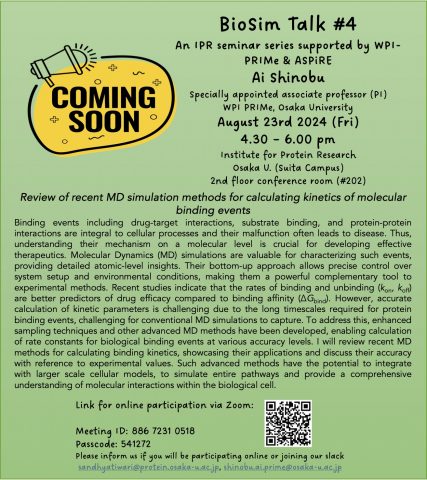![]()
NEWSIPR The University of Osaka
-

- NEWS
- [8.23 (Fri)] IPR Seminar: BioSim Talk #4
Seminar
2024.08.19
[8.23 (Fri)] IPR Seminar: BioSim Talk #4
BioSim Talk #4
(An IPR seminar series supported by WPI PRIMe and ASPiRE)
Date: August 23rd, 2024 (Fri)
Time: 4.30 – 6.00 pm
Venue: 2F Conference Room (#202), Institute for Protein Research,
Osaka U. (Suita Campus), +Zoom
[Meeting ID: 886 7231 0518 / Passcode: 541272]
Please inform us if you will be participating online or joining our slack
sandhyatiwari[at]protein.osaka-u.ac.jp, shinobu.ai.prime[at]osaka-u.ac.jp (Please replace [at] with @.)
Review of recent MD simulation methods for calculating kinetics of molecular binding events
Speaker: Shinobu Ai
Specially Appointed Associate Professor (PI), WPI PRIMe, Osaka University
Binding events including drug-target interactions, substrate binding, and protein-protein interactions are integral to cellular processes and their malfunction often leads to disease. Thus, understanding their mechanism on a molecular level is crucial for developing effective therapeutics. Molecular Dynamics (MD) simulations are valuable for characterizing such events, providing detailed atomic-level insights. Their bottom-up approach allows precise control over system setup and environmental conditions, making them a powerful complementary tool to experimental methods. Recent studies indicate that the rates of binding and unbinding (kon, koff) are better predictors of drug efficacy compared to binding affinity (ΔGbind). However, accurate calculation of kinetic parameters is challenging due to the long timescales required for protein binding events, challenging for conventional MD simulations to capture. To address this, enhanced sampling techniques and other advanced MD methods have been developed, enabling calculation of rate constants for biological binding events at various accuracy levels. I will review recent MD methods for calculating binding kinetics, showcasing their applications and discuss their accuracy with reference to experimental values. Such advanced methods have the potential to integrate with larger scale cellular models, to simulate entire pathways and provide a comprehensive understanding of molecular interactions within the biological cell.



